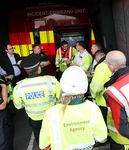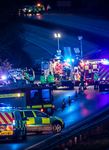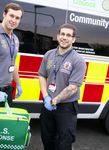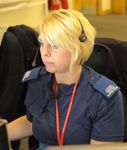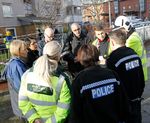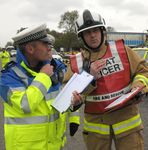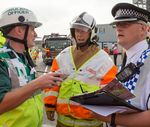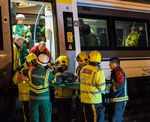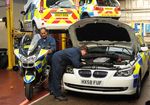National Overview 2016 - The Association ...
←
→
Page content transcription
If your browser does not render page correctly, please read the page content below
Contents
Foreword by the Emergency Services Collaboration Working Group...................................... 4
Headlines...................................................................................................................................... 5
First response and co-responding.............................................................................................. 6
First Response – Cardiac Arrest........................................................................................... 7
Emergency First Response................................................................................................... 9
Community Safety Responders (Pilot)................................................................................ 10
Telecare Response Service................................................................................................. 11
Co-responding.................................................................................................................... 12
Demand Management and Rationalisation............................................................................... 14
Forced Entry and Missing People...................................................................................... 15
Revised Policy on Sudden Deaths..................................................................................... 16
Clinical support desk – Triaging calls................................................................................. 17
Joint Response Unit (JRU)................................................................................................. 19
PCSOs employed as RDS Firefighters (Pilot)..................................................................... 20
Rural Intervention Vehicles................................................................................................. 21
Shared Estates and Assets........................................................................................................ 22
Shared HQ.......................................................................................................................... 23
Joint Vehicle Workshop...................................................................................................... 24
Shared Training Centre....................................................................................................... 26
Tri-Service Hub................................................................................................................... 28
Joint Facilities..................................................................................................................... 29
Dynamic Activation Posts (DAPs)....................................................................................... 33
FUTURE: Fleet Procurement.............................................................................................. 33
Joint Control Rooms.................................................................................................................. 34
Strategic Alliances and Partnerships........................................................................................ 38
Information Sharing.................................................................................................................... 48
Community Safety – Operation Insight.............................................................................. 49
Information Sharing Protocol and Operational Learning.................................................... 50
Embedded Fire Officer into the North West Counter Terrorism Unit and
Civil Contingencies Resilience Unit.................................................................................... 52
Wider Collaboration................................................................................................................... 54
Community Engagement.................................................................................................... 55
Housing............................................................................................................................... 60
Local Resilience Forums.................................................................................................... 65
NPCC/CFOA National Overview of Police and Fire Collaboration.......................................... 68
Consensus Statement on Improving Health and Wellbeing.................................................... 70
CFOA/AACE Consensus Statement.......................................................................................... 72
AACE/NPCC Managing Demand Best Practice Guide............................................................ 74
Service Information.................................................................................................................... 76
Service index.............................................................................................................................. 86Foreword
by the Emergency Services Working Group
In support of a desire at both a national and The refreshed overview is designed to provide
local level to support emergency service services and associations with a variety of
collaboration, and in response to a request examples of significant collaborative projects
from central government to outline a number from across the country, which are designed
of collaborative projects suitable for upscaling to help deliver the efficient and effective
on either a regional or national level; the emergency services everyone would like to see.
Emergency Services Collaboration Working The review is designed to be as accessible as
Group (ESCWG) have been working with possible and to be used in accordance with
services and associations to refresh the local needs and priorities. The ESCWG would
2014 National Overview with examples of like to express its thanks to the significant
collaborative projects, plans and initiatives number and variety of organisations who have
from across England and Wales. The examples provided examples of collaborative practice,
provided within this document are warmly and looks forward to being able to use the
welcomed and provide a real insight into the information to help drive the collaboration
sheer scale of progress over the course of the agenda forward; both across the emergency
last two years. services themselves and the wider public
sector.
About the Emergency Services Collaboration Working Group
The Emergency Services Collaboration Working Group was formed in September 2014 and
helps provide strategic leadership and coordination to help drive and improve emergency service
collaboration across England and Wales.
The working group comprises of senior leaders from the Association of Ambulance Chief
Executives (AACE), The National Police Chiefs’ Council (NPCC), Association of Police and Crime
Commissioners (APCC), College of Policing, Chief Fire Officers Association (CFOA), the Local
Government Association (LGA) and the Maritime and Coastguard Agency (MCA).
LEADBEYOND
4 Emergency Services Collaboration Working Group – National OverviewHeadlines
29% reduction 5 minute average
in burglaries response time
Essex – page 49 London – page 19
Increased chance of
survival in the event
of a cardiac arrest
from 9% to 58.6%
First response – page 7
138 hours of Police estates
Police time saved budget reduced
in 5 months by up to £1.490m
Lancashire – page 16 Hampshire – page 24
5First Response and
Co-responding
The following projects have resulted in In this section
faster response times and enhanced First Response – Cardiac Arrest
interoperability between the services. Emergency First Response
Taxpayers will see greater efficiency
Community Safety Responders (Pilot)
from their services as a result of the
collaborative co-ordinated responses. Telecare Response Service
Enhanced communication and Co-responding
understanding of other services is
improving the effectiveness of the
services across the board.
6 Emergency Services Collaboration Working Group – National Overview• Three fire stations in the London Borough of
First Response – Greenwich are the first in London to install
Cardiac Arrest defibrillators on the outside of their buildings,
these have been installed as part of the
• London London Ambulance Service ‘Shockingly
• Merseyside (Pilot) Easy’ campaign to install more defibrillators
across London.
• Greater Manchester
• Wales (Mid and West) Merseyside (Pilot)
• Essex (February 2016)
• Hertfordshire Merseyside Police and NWAS
Police have AEDs in a number of vehicles
Background and have received training from NWAS which
enables them to respond to any spontaneous
In the UK approximately 30,000 people incidents. Consideration is being given to the
sustain cardiac arrests outside of hospital and police participating in a pilot with MFRS and
are treated by emergency medical services NWAS which involves formal deployment
(EMS) each year. Electrical defibrillation is well as part of the Emergency Services Medical
established as the only effective therapy for Response scheme.
cardiac arrest caused by ventricular defibrillation
(VF) or pulseless ventricular tachycardia (VT). Greater Manchester
GMP, GMFRS and NWAS
In the event of suspected cardiac arrests
(SCAs), police and fire and rescue personnel All GMFRS firefighters across the entire Service
are equipped to respond with automated now respond to cardiac arrests in support of
external defibrillators (AEDs), providing prompter the North West Ambulance Service (NWAS)
response times and increasing patients’ chances and mobilise to 20% of all cardiac arrests in
of survival and subsequent quality of life. Greater Manchester.
Implementation Public Access Defibrillators (PADs) will be
provided in all GMFRS fire stations, for use
London by employees, visitors and members of the
(November 2015) community. Elsewhere, the Service will increase
MPS and LAS the number and availability of PADs across the
region and map these life-saving kits so that
• In addition to equipping police cars in each 999 call handlers can provide callers with the
of the boroughs with AEDs, AEDs will also location of their nearest available defibrillator.
be placed in the public access areas of the GMFRS will also increase the number of
police station in each borough, enabling them ‘instructors and educators’ who can teach CPR
to respond to SCAs within a 100m radius of and the safe use of PADs to GM communities.
the station.
• After a successful pilot in three London All GMP traffic units, together with all armed
boroughs, the co-responding scheme response vehicles, have also been issued
between the Metropolitan Police Service and with an AED, with all officers involved having
London Ambulance Service (LAS) is being been trained in their use by NWAS (these,
rolled out across all London boroughs. however, are not dispatched by NWAS). This
• LAS have also been working with the City of initiative will also potentially also be introduced
London Police for over 10 years, automatically on motorcycle response units within the
alerting them to any SCA calls. Police cars and foreseeable future.
bikes are fitted with AEDs as well as having
AEDs installed within their three stations.
7Wales (Mid and West) Benefits
(December 2015)
MWWFRS and WAST Increased chance of survival
MWWFRS entered into discussions with In London the proportion of patients who
the Welsh Ambulance Trust (WAST) and experienced cardiac arrest who had a pulse
established a roll out programme with locations on arrival at hospital (known as return of
prioritised through consultation with WAST. spontaneous circulation – ROSC) was around
31%. For the Utstein comparator group (an
Essex international benchmark for a sub set of all
ECFRS and EEAS cardiac arrest patients) there was a ROSC rate
of 55.%. Overall survival to hospital discharge
Essex County Fire and Rescue Service (ECFRS) rates were 9.0% for all patients where
and the East of England Ambulance Service resuscitation was attempted and 31.5% for
(EEAS) NHS Trust successfully piloted a first those meeting the Utstein inclusion criteria.
responder scheme at Newport Fire Station and When early defibrillation was used 76.7%
the scheme has now been running at Newport of patients were reported to have sustained
Fire Station since its inception in 2012. ROSC to hospital and the overall survival to
discharge rate was 58.6%. This high survival
EEAS has extended its collaboration with rate demonstrates the importance of early
Fire and Rescue Services across the East of defibrillation. In London considerably more
England Region for co-responding to Cardiac patients received bystander cardiopulmonary
Arrest calls. There are now 5 counties and resuscitation (CPR) than ever before with 63.1%
25 FRS stations involved, Bedfordshire, of patients receiving CPR prior to LAS arrival.
Hertfordshire, Essex, Cambridgeshire and
Norfolk and plans for further development are In Mid and West Wales, the remote and isolated
being considered. nature of the communities means that whilst
FRS resources are usually very quickly on the
EEAS provides equipment including scene, there can be a considerable time delay
defibrillators, provides training for the fire before ambulance personnel are in attendance.
officers involved and has a dedicated Blue This scheme helps to ensure that treatment can
Light Collaboration Lead who support these be delivered in the shortest possible time.
schemes. The EEAS maintains contact with
the stations involved through the Collaboration In Essex, the first responder scheme was a
Lead or training officers. success with up to 100 medical emergencies
attended to a year by Newport first responders.
Hertfordshire
Hertforshire Fire and Rescue Service and
the East of England Ambulance Service
NHS Trust (EEAS)
Hertfordshire Fire and Rescue Service and
the East of England Ambulance Service have
embarked on a co-responding trial which sees
fire appliances from Watford and Stevenage
responding to cardiac arrest incidents alongside
ambulance colleagues. The trial forms part of
an Eastern region collaboration looking at how
fire and rescue service assets can be deployed
to assist the ambulance service in saving lives
and improving medical outcomes.
8 Emergency Services Collaboration Working Group – National OverviewFuture Emergency First
London Response
LAS are currently piloting a co-responding • Humberside
trial with the London Fire Brigade as part • South Yorkshire
of a national pilot in four London boroughs
(Merton, Wandsworth, Newham and
Lambeth). LFB Co responding pilot data is Background
encouraging, LFB have attended over 900
calls across 4 London boroughs with 24 The Emergency First Response (EFR) scheme
successful ROSC (Return of Spontaneous was set up to improve clinical outcomes and
Circulation). The results will be evaluated cardiac arrest survival rates with a focus on
before further implementation. servicing rural communities. The scheme
involves utilising on-call fire-fighters to provide
Essex an EFR in collaboration with the ambulance
service.
Essex County Fire and Rescue Service
(ECFRS) is now working more collaboratively Rural areas pose significant challenges to the
with the EEAS and the two services ambulance service when meeting the national
have discussed the benefits of the FRS eight minute response target, 75% of the time.
responding as First/Co-responders to The presence of on call fire stations in many
medical incidents across the region. of these areas means the FRS in an obvious
emergency service partner for the ambulance
Two full-time stations (Colchester and service to collaborate with to improve response
Basildon) and one on call station (Frinton-on- arrangements to time critical emergencies in
sea) started a six-month co-responder trial in local communities.
April 2016, which is due to finish in
September 2016. The pilot will then be Implementation
evaluated before any decisions are made to
roll out the scheme across the ECFRS. Humberside
FRS, YAS, EMAS
After an initial trial, the EFR scheme has now
been extended to a total of 17 fire stations
across the Humberside Fire and Rescue
Service (HFRS) area with more planned.
South Yorkshire
SYP, SYFR, YAS
The MoU between Yorkshire Ambulance
Service and the four fire and rescue services in
the Yorkshire and Humber region outlines the
incidents in which EFR will provide non invasive
treatment. Such incidents include: Cardiac
arrest, respiratory arrest, central chest pain
and collapse.
9Benefits
Community Safety
Faster response times Responders (Pilot)
• In Humberside, EFR performance in meeting • County Durham and Darlington
the eight minute standard in 75% of incidents (May 2015 – March 2017)
has been good to date and during some
periods has been as high as 83%.
• HFRS attended almost 4000 EFR incidents Background
in the past year and this figure is predicted
to increase further as the capability is Community Safety Responders (CSRs) are
expanded. intended to improve the delivery of blue
• In South Yorkshire, EFRs were mobilised to light services in and around the rural town
125 incidents between 1 November 2015 of Stanhope. They will deliver community
and 1 February 2016. prevention and protection models and flexible
emergency response arrangements during this
Enabling future collaboration pilot scheme.
As a result of the improved cross service CSRs will perform the joint roles of Police
awareness of managers in both services Community Support Officer (PCSO), Retained
additional opportunities for further collaboration on-call Fire-fighter and an Emergency Medical
are now also being explored. Responder (EMR) trained to attend ambulance
service Red 1 and 2 category calls from their
Future base within the local fire and police stations
in Stanhope.
From a regional perspective, on-call stations
in North Yorkshire, West Yorkshire and South The CSRs will undertake community safety
Yorkshire are adopting the same design and initiatives incorporating elements from all three
operating principles. A Yorkshire regional blue light services, which will deliver efficiency
working group has also been established, savings across the blue light services through
which includes YAS, to ensure consistency the use of joint resources.
and the maintenance of the scheme within
the region. Implementation
The CSR roles were advertised internally
within the police and FRS and two successful
candidates were appointed in November 2015.
Both candidates began their operational roles
in February 2016.
Evaluation
Durham Constabulary will assume responsibility
for evaluating the success of the project but
will collect data from all three services on input/
output/outcome measures and costs.
10 Emergency Services Collaboration Working Group – National OverviewBenefits (Anticipated)
Telecare Response
Improving the safety of communities in the Service
Stanhope area
• Gloucestershire
• Increased the assurance and confidence (June 2015)
within communities in the blue light services
through the provision of highly visible and
approachable CSRs. Background
Advancement of joint blue light service Telecare equipment supports people to live
strategic objectives safely and independently at home. Using
special sensors Telecare can detect potential
• Strategic intent to explore possibilities for emergencies at home, for instance: Falls,
co-working across blue light services. wandering, medication mismanagement, fire,
• Combined training opportunities leading to flooding, carbon monoxide and gas leaks.
a shared ethos, reduced bureaucracy and
improved situational awareness. Following a short pilot in North Cotswold
• Increased sharing of intelligence between between July and September 2015,
services to improve the quality of service Gloucestershire FRS became the first
delivered to local communities. responders to all Telecare calls across the
• Provide an enhanced collaborative country using retained fire fighters.
contribution to the Safer Durham Partnership.
Benefits
Enabling vulnerable individuals to remain
at home
• The initial pilot in North Cotswold between
mid-June to mid-Sept enabled 28 people to
return home or remain in their own homes.
The alternative for these people would have
been either a short or long term placement in
a care home.
• The pilot provided a significant social return
on investment with care home placements,
ambulance conveyances, emergency
admissions and hospital stays, and police
and fire and rescue service call outs being
avoided.
• A conservative assumption for savings of
the pilot would be £371,028 (full year effect).
If this is this was applied across the County’s
six localities – this could turn an annual
social return on investment in excess of
£2.2 per annum.
11Benefits
Co-responding
• Thames Valley Faster response
• Devon and Cornwall
• SCAS has seen an improvement in their
statutory response times, which in turn has
Background provided greater patient outcomes and
allowed ambulance resources to be used
Co Responders are able to carry out clinical more effectively.
care and basic life support whilst ambulance • The co-responding scheme allows fire-
clinicians are en route to the incident. fighters with enhanced medical training
to provide a faster response in medical
Implementation emergencies in rural areas, ensuring
residents have the best chance of survival.
Thames Valley
Buckinghamshire, Hampshire, Oxfordshire and Call demand
Royal Berkshire FRAs and SCAS
• Since 1 April 2015, the three Thames Valley
• Each of the four fire and rescue services FRSs have responded to just over 3000 calls
within the South Central Ambulance Service alone, this number will dramatically increase
(SCAS) area are undertaking co-responding as the future planned schemes come on
or first responding schemes of one form or line. Hampshire FRS on average responds
another. to some 10,000 co-responding incidents
• The project was co-ordinated by an officer annually. This clearly indicates the viability
from SCAS and an FRS station manager and positive benefits that co-responding
(the post was jointly funded by the four FRS brings to the communities served by the
involved). four FRSs.
• Co-Responders on the Lizard Peninsula
Devon and Cornwall attend on average 47 life-threatening and
Cornwall Fire Service and SWASFT non-emergency calls per year.
• Co-responder service for residents of Cost savings
the Lizard Peninsula. Co-responders are
firefighters who are trained and assessed The ambulance service is making cost savings
in basic life support procedures, including due to the increase in response targets being
the use of AEDs and oxygen therapy. South met (reducing fines for not achieving targets).
Western Ambulance Service NHS Foundation A reduction in private ambulance companies
Trust (SWASFT) identifies emergencies that being hired also contributes to cost savings.
are appropriate for co-responders to attend.
• A scheme extending this service to Consistency and Confidence
the Community of Poluran went live on
17th February 2016. The co-responding There is now a single medical response training
scheme was set up to address the package (Intermediate Emergency Care IEC)
problems associated with the geographical being rolled out across the SCAS region to
location where it is nearly impossible the four FRSs. This has ensured consistency
for the ambulance service to achieve throughout the region and a confidence among
the eight-minute response target set by crews, providing better care to casualties
the Government. attended to by FRS personnel at all incidents.
12 Emergency Services Collaboration Working Group – National Overview13
Demand Management
and Rationalisation
Demand management and the In this section
rationalisation of services reduces Forced Entry and Missing People
harm by improving the capability of Revised Policy on Sudden Deaths
services to deal with incidents. The
Clinical support desk – Triaging calls
services are able to mobilise a faster
response to incidents and performance Joint Response Unit (JRU)
is enhanced by improved PCSOs employed as RDS Firefighters
interoperability. Through deploying (Pilot)
resources appropriately and effectively, Rural Intervention Vehicles
the emergency services have greater
capacity to deal with other incidents.
14 Emergency Services Collaboration Working Group – National OverviewHampshire
Forced Entry and (December 2015 – Pilot)
Missing People HFRS, SCAS and Hampshire Police
• Essex A MoU has been drafted to cover scenarios
• Hampshire (Pilot) such as managing security of the premises,
boarding up, financial considerations etc.
• Lancashire
The pilot is ongoing and results are
• Surrey/Sussex being reviewed by the three services on
• West Midlands a regular basis.
Background Lancashire
(June 2015)
There has historically been a high demand LFRS, NWAS and Lancashire Police
on the police for gaining entry to properties.
This new initiative sees the fire services There is a MoU in place as standard practice.
being deployed instead of the police to An evaluation of the period from June-October
assist other responding agencies who 2015 showed that 355 deployments in the first
require access to a property. five months of the project.
The Fire Service is also able to provide Surrey and Sussex
additional support and specialist equipment (January 2014)
in cases involving missing people. Surrey Police, Surrey FRS and SECAmb
This forms part of Surrey and Sussex’s ESC
Implementation
programme and Joint Operational Response
project which sees the six emergency services
Essex
working together to co-design the way services
(December 2015)
are delivered.
EEAS and ECFRS
• Requests from the Ambulance for
collapsed behind doors go directly to the
ECFRS Control room which then mobilise
accordingly. ECFRS assist by using their
expertise and complicated entry procedures
and larger equipment (which is more readily
available) to gain entry more effectively and
efficiently than the Police.
• Additionally ECFRS provide support to police
searches (such as high risk missing persons)
where ECFRS provide additional personnel
and specialist assets (USAR, thermal
imaging, Cadaver dogs) to help with the
search on the ground. In such cases the ILO
in ECFRS is contacted who decided on the
support available.
15West Midlands
West Midlands Police and WMFRS Revised Policy on
WMFRS’ Technical Resource Uni (TRU) provides
Sudden Deaths
support to High Risk Missing Person (Misper) • Hampshire
searches – including search management, open (2013)
area seatch and water search. TRU has an
• Hampshire police and SCAS
agreement based on trusted partner status, that
they will provide support at the request of a PolSa.
Background
Joint training exercises have been undertaken
for Misper searches with TRU and the Hampshire Constabulary revised force policy
Association of Lowland Search and Rescue. around declaring life extinct at sudden deaths
in 2013. Policy now allows officers to verify
Benefits death where a person is ‘obviously dead’
and policy covers this in more detail. This can
Performance Improvement reduce police time in attendance at sudden
deaths and keeps ambulance crews free to
In Surrey: respond to other calls more promptly.
• In 2015, Surrey FRS attended 646 incidents Implementation
at the request of SECAmb to gain entry and
arrived within an average of 8 minutes and • This represented a culture change for police
46 seconds. The boarding up contract has offices and took time to embed. SCAS
only been called on in 48 instances of gaining has been very clear, if there is any doubt
entry, a significant reduction, and IECR skills whatsoever that a person is dead they will
were used on 43 occasions to provide care attend as a high priority. However, they will
for the patient and assist ambulance crews. expect that the officer attending or member
• Specialist thermal imaging equipment of the public is carrying out CPR/ emergency
belonging to the Fire Service facilitated the first aid.
discovery of a missing child within minutes of
the Fire Service being on the scene.
Financial Savings
• In Lancashire, the first 5 months saved 138
hours of police time.
• Fewer instances of damage caused as a result
of forced entry, reducing costs for repair work
to property or costs incurred from civil litigation.
Future
Bedfordshire Police and Bedfordshire Fire
and Rescue Service are currently in talks to
discuss the possibility of the Fire and Rescue
Service responding to requests for forced
entry from the Ambulance Service. They
are also exploring the possibility of the Fire
Service assisting the Police when searching
for vulnerable missing persons.
16 Emergency Services Collaboration Working Group – National OverviewImplementation
Clinical support desk –
Triaging calls Hampshire
Hampshire Police and SCAS
• Hampshire
• Greater Manchester • SCAS launched their Clinical Support Desk
• London around 7 years ago. Police use of this facility
was piloted in one area around 4 years ago
• Merseyside
and can now be used by officers anywhere
• Surrey and Sussex in the county. The ability for the patient and/
or the officer to speak directly to a clinician in
Background SCAS EOC can often negate the need for an
ambulance to attend an in turn free up police
Within the North West area, there is evidence resources.
to demonstrate that up to 45% of Police • Experience has shown that police officers
requests to the Trust for an ambulance are need to be reminded to use this service on
not conveyed to hospital or another care a regular basis. Police officers tend to wish
facility following assessment at scene. Clinical to err on the side of caution and default to
support desks assist personnel at the scene requesting an ambulance.
to determine the best course of action, often • Force policy was revised in 2014 to account
freeing up ambulance deployments for more for the small number of occasions when a
serious incidents. police vehicle is used to transport a patient to
A&E. Use of the Clinical Support Desk forms
part of risk assessment process to identify if
it in the patient’s interest to be transported by
police or wait for an ambulance crew.
17Greater Manchester Surrey and Sussex
(November 2015) (December 2014)
GMP and NWAS Surrey and Borders Partnership NHS
Foundation Trust, Surrey Police and
There is an NWAS Urgent Care Desk located Sussex Police
in GMP’s Emergency Operations Centre which
provides clinical advice to Police Officers on the • Surrey Police in collaboration with Surrey
ground. and Borders Partnership NHS foundation
trust have implemented a ‘Hear and solve’
London programme which allows a desk based
(October 2015) team to provide advice on certain types of
MPS and LAS incidents without the need for attendance.
This follows a pilot placing mental health
• Instead of automatically sending an practitioners from Surrey and Borders
ambulance response to all police requests, Partnership NHS foundation trust into the
a dedicated team in the control room review Surrey Police Contact centre two evenings a
the cases that come in via control link (as week.
opposed to those coming through the 999 • Mental health practitioner posts have now
system) to determine the patient’s condition. been established to cover all late shifts 7
This enables the most appropriate response days a week.
to be given, which in some cases may be • Sussex police are now actively progressing
clinical advice given directly to the patient. the same model and both forces are sharing
• Operating 24/7 since the end of October, materials and experience.
the team aims to help up to 700 patients a
week without the need for an ambulance Benefits
response to be sent – that is 60% of all
police requests. Efficiency
Merseyside • In Merseyside, an initial review of the scheme
(April 2015) showed that 42% of police requests for
Merseyside Police and NWAS ambulance were dealt with via hear and treat
as opposed to an ambulance deployment. In
• A paramedic is based with the Police in the Greater Manchester,
Joint Command Centre from 10.00-00.00 • In Surrey, for the evaluation of the ‘Hear
Monday to Saturday and 11.00-00.00 on and solve’ pilot 88 calls were evaluated. Of
Sunday. The NWAS triage allows the patient to these, 71 incidents involved a person already
be spoken to via the ‘hear and treat’ process, known to Surrey and Borders Partnership
whilst still in company of the Police Officer. and at least 22 avoided police deployment
• Merseyside Police in partnership with because of mental health support at the
Merseycare and 5 boroughs Health Care point of report.
Trusts have worked together to secure
funding for Mental Health Triage Schemes.
Mental Health Practitioners (MHP) based at Future
the JCC provide advice to the officer over the
phone and make relevant referrals for follow- In Merseyside, work is currently being
up. However where the MHP is required undertaken to consider extending these
at the scene, the Mental Health Triage Car schemes to MFRS.
(consisting of a MHP and PO) will attend
incidents to provide an assessment, advice
and support to assist with resolution and
the outcome of the incident. This service
operates 7 days a week 16.00-00.00.
18 Emergency Services Collaboration Working Group – National OverviewBenefits
Joint Response Unit
(JRU) • Provides the ability to give advice over
the MPS radio and ability to hear when
• London police units arrive on scene at incidents
(2011) (bypassing RVP).
• Metropolitan Police Service and • Police officers are released from incidents
significantly earlier and there is increased
London Ambulance Service
availability to boroughs during peak times.
• Large alcohol/assault related call volume
Background dealt with.
• Police custody/front office also covered.
A London Ambulance Service fast response • Paramedics integrate with teams and
vehicle with one paramedic responds solely to join parades.
police requests for medical assistance (except
Red 1 calls). Figures (Nov 2012 – Dec 2015)
JRU aims to provide on-scene triage, • 21,187 activations by JRUs.
assessment and treatment of patients. JRU • 16,694 incidents attended.
is able to discharge the patient on-scene and • 13,217 incidents where they were the only
cancel LAS ambulances, resulting in a higher vehicle on scene.
number of ambulances available for other calls. • 5 minute average response time.
• 79.3% of JRU attendances did not require a
The Metropolitan Police Service (MPS) is one full ambulance deployment.
of the highest volume generators of calls to • Deployment against LAS target for a Cat A8
the LAS (100,000 calls a year), but responses incident has improved from 60% within target
to these calls are often delayed due to higher time before the JRU to 82.3%
category calls. This significantly ties up • The number of incidents where the MPS
resources and can lead to officers transporting have had an issue with LAS attendance have
casualties to Hospital themselves. fallen by 86% over the same period.
• Reduction in officers transporting a casualty
Implementation to hospital from 196 before the introduction
of the JRU to 29 following 5 months of
• The JRU was initially piloted in Hackney in operation.
2011. It’s now been successfully rolled out in
12 London boroughs and has the potential to
operate across London.
• JRUs are additional to normal LAS
deployments and are ring fenced for police
calls during the busiest period (18:30 – 06:30
Thursday to Saturday).
19Benefits
PCSOs employed as
RDS Firefighters (Pilot) At the end of the pilot we will evaluate and
measure how much effective RDS cover the
• West Mercia PCSOs were able to provide and establish how
(August 2015) they contributed to the improved availability of
• Hereford and Worcester FRS, a fire engine and enhanced crewing levels.
Shropshire FRS and West
• Improved joint understanding and information
Mercia Police sharing at a local level.
• The pilot scheme may be expanded to
Background other areas and provides a basis for the
consideration of potential joint PCSO/RDS
A move to closer joint working in a number Firefighter funded roles, thereby offering
of areas between WMP and the two FRSs better FRS RDS fire cover and increased
within its boundaries has sought to explore a PCSOs in selected areas through effective
wide range of options to share resources and joint funding.
work more effectively. As well as a number • Future employment of more PCSOs
of co-location opportunities (which includes especially in remote rural areas.
proposed new build joint fire and police • Potential integration of the FRS Community
stations), a joint mobilising and control function Safety role into the existing PCSO role.
and shared HQ, the opportunity to utilise WMP
PCSOs being employed as RDS Fire-fighters
was proposed.
Implementation
• Delivery of the project was undertaken by
Shropshire FRS.
• A Working Group was established made up
of representatives from WMP, all FRSs and
Unison (PCSOs Trade Union). A concept was
developed and parameters and agreements
on how the one year pilot scheme would
work were reached. This has resulted in
seven PCSOs being employed as RDS Fire-
fighters who commenced FRS training on
25th January 2016.
20 Emergency Services Collaboration Working Group – National OverviewBenefits
Rural Intervention
Vehicles • The RIVs have increased the visibility of the
emergency services in rural locations.
• Northamptonshire • The Community Safety Manager in South
(February 2016) Northants believes this has helped to
• Northamptonshire Police and increase public confidence in the emergency
services and community safety from 51% to
Northamptonshire FRS
60% in the period it has been in operation.
• The RIVs quite often arrive at a scene faster
Background than other resources and have been able
to stand down other resources, before they
In March 2014, the Interoperability Board arrive, meaning a reduction in fuel costs of
supported the proposal to scope the trial of larger appliances and road risk.
a jointly crewed Fire/Police response vehicle • The operatives have demonstrated that when
(operated by a Police Constable and a Watch deployed in preventative situations, the RIVs
Manager) which would be responsible for can save lives.
providing greater visibility in rural areas and • Initial concerns about brand, perceptions,
focus more broadly on community safety issues role and identity have failed to materialise.
than just traditional areas of Police and Fire • Other partners have bought into the concept
business. and are keen to assist in the pilot’s future
development in their localities.
The RIVs have been mobilised to incidents
such as suspicious circumstances, missing
person searches, road traffic collisions,
breakdowns, reassurance visits and conducting
shared intelligence and investigations. The
operatives also responded to a stabbing
incident, an incident involving an unexploded
grenade and an attempted suicide.
Implementation
• The two Rural Intervention Vehicles carried
out a total of 315 local engagement activities
ranging from school visits, recruitment
events, home-fire safety checks, crime
prevention, farm watch and road watch
engagement activities.
• On the response side, the RIV operatives
were given the freedom to determine which
incidents they thought that they should be
capable of responding to. After six months
of carrying on the pilot it was greed that
both operatives could be mobilised to road
traffic collisions, breakdowns, suspicious
circumstances, missing person searches,
welfare checks, assurance visits and joint
intelligence and risk gathering exercises. The
two RIVS responded to a total of 219 such
incidents over a period of twelve months.
21Shared Estates and Assets
Shared estates and assets facilitate In this section
closer dialogue between the services. Shared HQ
Savings are generated through the Joint Vehicle Workshop
removal of duplication of property
Shared Training Centre
costs, sharing utilities and the
possibility of sale or re-sale of existing Tri-Service Hub
sites and properties. Costs are also Joint Facilities
reduced due to diminished travel time. Dynamic Activation Posts (DAPs)
FUTURE: Fleet Procurement
22 Emergency Services Collaboration Working Group – National OverviewIssues with implementing the project:
Shared HQ
• IS present a major challenge in view of the
• Cheshire
heightened PSN police security standards
• Derbyshire which DFRS are not subject to and their
• Hampshire systems do not achieve.
• It has been necessary for the police and fire
There are currently ongoing projects in Cheshire, services to implement different networks
Derbyshire and Hampshire to build shared HQs which carries an extra cost and adds to
for the Police and Fire and Rescue Services. complications of managing the HQ.
• The two organisations have had to adopt
In Hampshire, a key driver for sharing estates different telephony solutions and are currently
across the Strategic Headquarters function is exploring the potential to have a joint Wi-Fi
the budget pressures and funding cuts affecting arrangement or again whether separate
both organisations. Through the development arrangements are needed.
of a joint estate partnership, buildings can be • Delivering some of the benefits from the
shared in order to reduce overall running costs, joint HQ will be more difficult due to the
produce revenue savings and increase estate inconsistency in the network and telecoms
utilisation. The Joint Strategic HQ will therefore arrangements.
allow partner agencies to do more for less. • Logistical problems of vetting 200 fire staff in
line with police security standards.
Implementation
Cheshire
Derbyshire (June 2014 – 2018)
(July 2013 – full occupation exp. Nov 2016) Cheshire Constabulary and Cheshire Fire and
Derbyshire Police and Fire Service Rescue Service
• Both services are pooling their resources A shared Headquarters for police and fire
to build a new joint headquarters on the will be established at the existing police
constabulary site at Ripley, to co-locate core Headquarters site by 2018 providing single
police and fire services in one HQ. integrated transactional and professional
• DCLG provided funding of £1.5m towards support functions to both the police and fire
the Fire Service share of the project in 2014. and rescue services under the employment of
Police submitted a bid for the innovation fund the Chief Constable. It is estimated that the
in 2015 for the project but this was rejected. move will produce combined annual savings
• The two estates teams have worked together of over £1.5 million.
to deliver the project, with the Police taking
the lead. Hampshire
• A Limited Liability Partnership has been (February 2015)
established to own the joint HQ which allows Hampshire Constabulary and HFRS
the Fire Service an asset for their investment
and may facilitate further joint building In 2014 Hampshire constabulary and
projects (i.e. a Joint Training Centre). HFRS agreed the plans for a Joint Strategic
• A joint board (co-chaired by the PCC and HQ. A Strategic Command Centre is also
Chair of the Fire Authority with a Chief being constructed which will facilitate joint
Constable/ Chief Fire Officer representative) agency responses and the ability of both
is supported by a management board and organisations to support single agency led
project groups which has been established incidents in both a strategic and tactical
to implement the project and manage the capacity. The flexible space can also be
building once it has been completed. utilised for meetings and training.
23Benefits
Joint Vehicle Workshop
Savings • Cheshire
• Humberside
• In Derbyshire, it is estimated that there will be
£1.5m of on going savings over the next 10
years due to closer savings working. In Humberside, prior to the current
• In Hampshire the HFRA will receive revenue arrangement, HFRS had vehicle and equipment
contribution of up to £580000 p.a. from maintenance workshops in three separate
the police by sharing of HFRS space. The locations. Partly due to the age of the premises,
relocation of police teams contributes this arrangement was inefficient and did not
towards reducing the Police estates budget provide a good modern working environment.
by up to £1.490m. The equipment workshop was geographically
• In Hampshire the Strategic Control Centre will remote from vehicle workshops which caused
directly reduce travel costs and time wasted additional vehicle movement and prevented the
when working on joint agency responses for efficient deployment of personnel.
example the Adverse Weather Centre during
the recent floods in Hampshire. Implementation
Closer working Humberside
(November 2013)
• Derbyshire Police and Fire Services are now Humberside Police fleet services and HFRS
developing a project for a joint training centre vehicle and equipment maintenance function
and Firearms range.
• Derbyshire Police and Fire Services are also • The possibility of Yorkshire Ambulance
looking at opportunities to work together to Service partaking in the project was explored
rationalise their estate with shared premises however they chose not to join due to the
across the country. incompatibility of the geographical location
• The Hampshire Joint Strategic HQ houses with that of their service area.
senior teams in close proximity. This • To establish the Joint Venture Company
increases contact between the senior teams – Emergency Services Fleet Management
and enables already productive relationships (Humberside) Ltd (ESFM), a two-phase
to flourish in the same way which has (delivery and operational) approach was
been witnessed in the operational teams in undertaken.
Southampton which are already co-located
at Redbridge fire station. The delivery phase
• Three groups were instrumental in the
Future
project’s delivery: The Strategic Steering
Group (SSG), The Project Delivery Team and
Norfolk
the Shadow Governance Board.
• The SSG set the parameters for the Project
Agreement has been reached for a total
Delivery Team to work to and ultimately
relocation of Fire Headquarters to Police
reported to the PCC and HFA. They
OCC at Wymondham. The Principle Officer
also agreed costs for the project, tenure
Group has moved into an area shared with
arrangements and maintenance of the
the Police Chief Officer Team to enable
relevant risk registers.
closer working and decision making.
• The Project Delivery Team was responsible
for areas such as technical specifications
and utilisation of facilities, all personnel
issues and setting project milestones. This
was overseen by the SSG who in turn had
24 Emergency Services Collaboration Working Group – National Overviewtheir governance arrangements tested by Cheshire
the Shadow Governance Board. The board (November 2015)
additionally developed a joint constitution and Cheshire Constabulary and Cheshire Fire and
a set of key performance indicators as well Rescue Service
as agreeing the composition of the ESFM
Management team. As part of Cheshire’s Blue Light Collaboration
Programme, plans were made by the Executive
The operational phase Board to create a joint vehicle workshop and
associated parking.
• This phase is managed by the ESFM Board
who receives reports from the Management The proposals to redevelop the vehicle
Team. They are also responsible for budget maintenance facilities will create an extra
setting and agreeing strategic priorities, they 621m2 which leaves 1,915m2 which will be
report to the PCC and the HFA. Sitting under required to be made available from within
the Board is the ESFM Management Team space currently utilised by Cheshire Police
who deal with the day to day running of departments, this represents 11% of the
the ESFM such as workloads, recruitment, current NIA.
management, budgets and performance
measurement. The functions to be moved on to the Police
HQ site are in all cases highly comparable with
the functions already operated from the site
and the amount of building works for most
of the proposals is relatively modest. The
exception to this is that there will need to be
a major extension of the vehicle workshops
25to accommodate both the additional number
of vehicles and also the higher proportion of Shared Training Centre
HGVs and their ancillary equipment. The cost
• County Durham and Darlington
to extend the vehicle maintenance facilities is
the largest single implementation cost. • Cumbria
• Derbyshire
Benefits
The blue light services share many
Savings requirements for specialist training facility
provision (i.e. working at heights platforms,
• In Humberside the collaboration produces building search, hazardous area response,
significant capital and annual revenue savings fast roads environments, building entry and
for HFRS. There has been a significant saving extraction) which are costly and by their very
in capital outlay for HFRS when compared to nature, underutilised.
a solo project as well as some year on year
revenue savings. Joint training facilities provide long term
• In-house MOT testing can be offered outside financial efficiencies for each organisation and
the partnership; reduced overtime and support the JESIP principle of “Ensuring that
building maintenance costs; the servicing the blue light services are trained and exercised
of specialist appliances and procurement to work together as effectively as possible at
efficiencies. all levels of command in response to major
or complex incidents so that as many lives as
Closer working possible can be saved”.
• The project has facilitated transfer of skills In County Durham and Darlington, the
and knowledge between Humberside Police previous CDDFRS HQ had reached the end
Fleet Management and HFRS Fleet and of its economic life and required significant
Equipment Maintenance personnel. investment or replacement to retain its
• The Humberside project is seen as functionality and as a result they are building
encouraging future joint working and a new training centre in collaboration with
partnerships with other emergency services Durham Police.
in Humberside and beyond.
Derbyshire police and Derbyshire Fire and
Rescue are currently working together to build
a training centre and firearms range.
Implementation
County Durham and Darlington
(August 2010 – August 2015)
CDDFRS and Durham police
• The project was initiated to create a new
training centre for CDDFRAS and shared
command training facilities with Durham police.
• The new centre has consolidated several
different training locations into one central
venue with ‘state of the art’ purpose built
facilities and the shared command training
suite enables immersive learning using the
latest computer simulation software.
26 Emergency Services Collaboration Working Group – National Overview• The agreement between Durham police and Benefits
CDDFRS allows 70 days for the delivery
of Police related development with the Effectiveness
remainder of the year allocated for fire service
incident command training. • In Cumbria, expansion of the facility will
enable BA training in hot and realistic
Cumbria conditions. This will assist in recruitment and
(2015) ongoing BA training to comply with both
Cumbria Constabulary and Cumbria Fire and Operational Training Guidance Breathing
Rescue Service Apparatus and Operational Guidance
Breathing Apparatus.
• At present a Fire Behaviour Training facility
exists at Penrith which is shared by Cumbria Savings
police for public order training.
• The services are currently in talks to discuss • Reduced running costs have provided
expanding the training facilities to develop Durham police with estimated annual savings
a larger training facility to be used by both in excess of £38,000.
police and fire staff. • In Derbyshire, the joint facility was deemed
to be the best and most cost effective option
Derbyshire for both organisations when replacing their
(Winter/Spring 2018) existing out of date facilities.
Derbyshire Constabulary and DFRS
Closer working
• Due to the combined needs of Derbyshire
Police to replace its firearms range and • In County Durham and Darlington, the
Derbyshire Fire and Rescue service need to shared command training suite supports
replace their training provision, the services collaboration between the CDDFRS and
have embarked on a joint project to build a Durham Police through a greater respective
training centre and firearms range. understanding of the operating protocols
• The centre will entail- and command of emergency incidents. The
–– A new Firearms Range that meets all joint command training delivered will also
current accreditation standard develop the shared situational awareness
–– Fire specific emergency services training between category one and two emergency
(fire house, water rescues, etc) responders.
–– Classroom based training for fire and police • In Derbyshire, the training centre and
officers firearms range will provide an environment
• Derbyshire Police is also in discussion with for multiple agencies to train and work
another police force to look at the potential together, furthering the JESIP programme,
for them to use the firearms range to ensure in preparation for critical and major incidents
maximum use of it. and civil emergencies.
• The project will be jointly procured and
delivered through the LLP (established to
own the joint HQ which allows the Fire
Service an asset for their investment).
27took place and the FPBLH stakeholders group
Tri-Service Hub was established. After submission from each
stakeholder, special planning commenced and
• Devon and Cornwall and Cumbria
an architect was appointed.
• At the time of writing, planning permission
Implementation has been granted but construction has not
yet commenced.
Devon and Cornwall
(2015) Benefits
Cornwall Fire and Rescue Service, DSFRS,
SWASFT and Devon and Cornwall Police Closer working
• Hayle Emergency Services Community Station • The tri-service hub in Cornwall realises
is the first in the UK to have been designed improved collaboration across emergency
and built for three Service’s needs. The station services achieved by a purpose built new
became operational in March 2015 and is facility with integration and cohabitation
home to England’s first Tri-Safety officer who at the heart of its design, and unique
covers Cornwall Fire and Rescue Service Emergency Tri-Service Officer role.
(CFRS), Devon and Cornwall Police and South • The tri-service hub in Cornwall encourages
Western Ambulance Service in Hayle. The cultural change, exploding myths around
officer’s duties involve youth engagement and integrated working and will enable Cornwall’s
tackling anti-social behaviour, health promotion communities to experience, comment on and
and prevention and addressing home fire safety. help shape future Blue Light Tri-Service projects.
• The Liskeard tri service hub is the primary
project in Cornwall and is being developed Public Safety
on evaluation of the Hayle station.
• Both Cranbrook and Sherford New Towns • The tri-service hub in Cornwall prioritises
have s106 land allocated for Police Stations community safety through the delivery of
to be built. Devon and Cornwall Police are intelligence led, customer focused services,
working with DFRS and the Ambulance Service coordinated by the Tri-Service Officer.
to provide tri blue light facilities upon these • The introduction of the tri-service officer role has
sites providing a more cost effective holistic proven to be highly successful, providing a highly
approach to emergency services provision. visible presence and offering a unique approach
in dealing with public safety and prevention.
Cumbria • Regular day to day collaboration facilitated
(June 2014 – Dec 2016) by FPBLH will enable the services to share
Cumbria County Council Fire and Rescue information and resources to identify and
Service, Cumbria Police, NWAS and Cumbria reduce risk to the most vulnerable in the
County Council community along with effective targeted
prevention interventions.
• Following a successful bid for £4.68 million • Enhanced community facilities in FPBLH will
from DCLG Fire Transformation Fund also support community youth activities such
2015/2016, CCCFRS were able to take steps as the young fire-fighter scheme.
to establish a tri-service hub in Furness – the
Furness Peninsula Blue Light Hub (FPBLH).
• The hub will provide office accommodation Future
and a shared training facility to enable joint
learning and development. In South Wales, the largest single Tri-Service
• In January 2015, a project manager was Centre in Wales is being established. Works on
appointed from the Cumbria County Council the South Wales Police HQ site are progressing
Strategic Investment& Property Unit. well. The Fire Service is being co-located and
• In February 2015, an inaugural project meeting the WAST 111 service locacted thereafter.
28 Emergency Services Collaboration Working Group – National OverviewYou can also read

